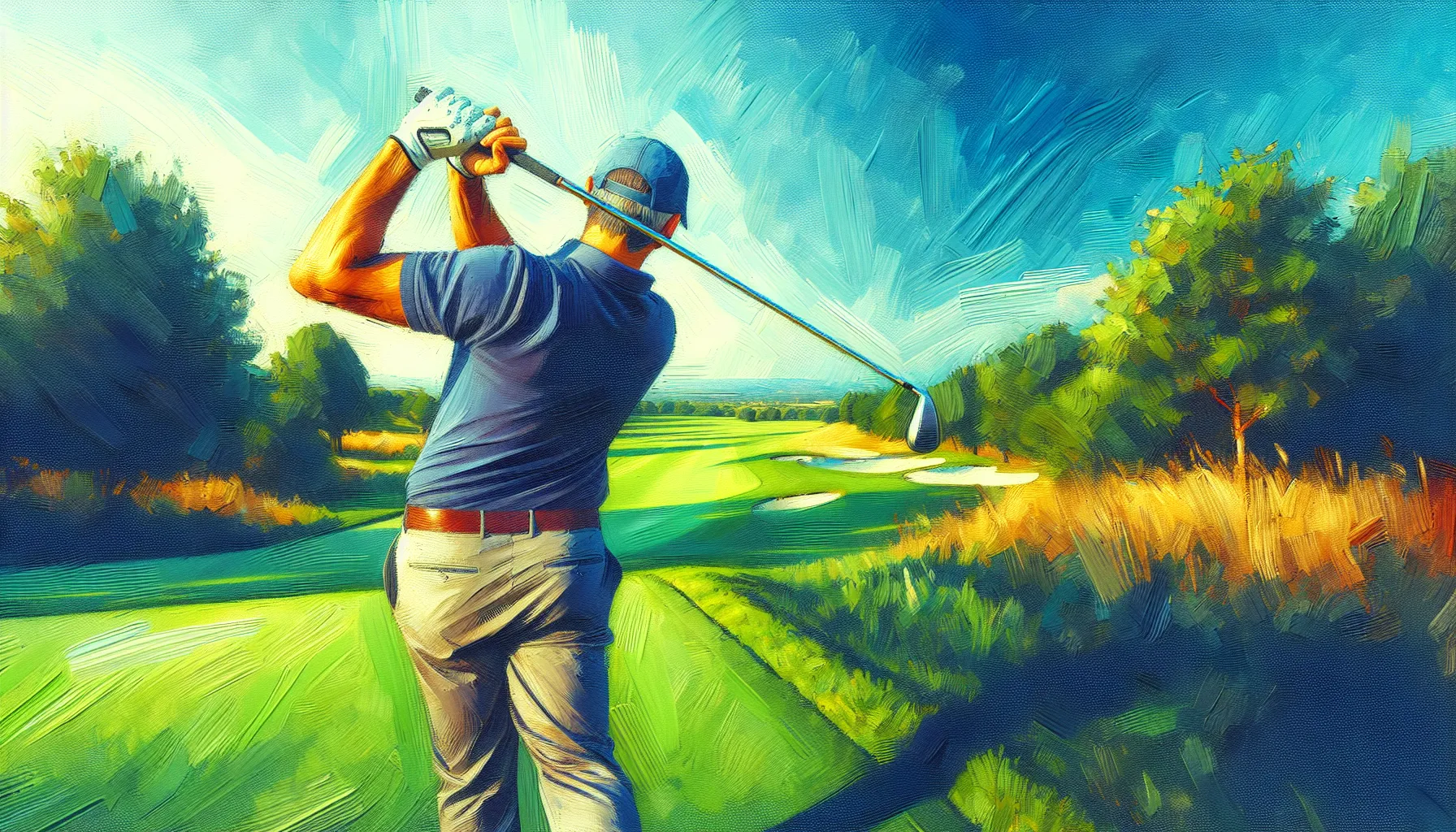How to Hit Lower Golf Shots: Master Your Trajectory for Better Scores
Welcome, weekend warriors and golf enthusiasts!
Are you tired of watching your golf balls soar high into the sky, only to be caught by the wind and pushed off course? Do you dream of hitting those crisp, penetrating shots that seem to defy gravity and cut through the air with laser-like precision?
Well, you're in the right place. In this comprehensive guide, we'll explore the art of hitting lower golf shots - a skill that can dramatically improve your game and help you navigate challenging weather conditions with confidence.
Take Control: Learn How Low Shots Can Lower Your Scores
As a fellow golfer who's spent countless hours on the course trying to master this technique, I know firsthand the frustration of struggling with ball flight. There's nothing quite like the sinking feeling of watching your perfectly aimed shot balloon into the air, only to be carried away by a gust of wind. But here's the good news: with the right knowledge and practice, you can learn to control your ball's trajectory and keep it low when needed.
Let me share a little secret with you - hitting lower golf shots isn't just about looking cool or impressing your buddies (although that's certainly a nice bonus). It's about giving yourself more options on the course, improving your accuracy, and ultimately, lowering your scores. Whether you're battling strong winds, trying to keep your ball under tree branches, or just aiming for more consistent shots, mastering the low ball flight is a game-changer.
So, are you ready to take your golf game to new heights by keeping your ball flight low? Let's dive in and discover how you can become the master of the low shot!
Hitting Lower Golf Shots: Tips for Better Control
When I first started golfing, I was all about hitting the ball as high and far as possible. I thought that was the key to impressing everyone on the course. Boy, was I wrong! It wasn't until a particularly windy day at my local links that I had my epiphany about low golf shots.
Picture this: I'm standing on the 7th tee, a long par 4 with the wind howling straight into my face. I set up, swing with all my might, and watch in dismay as my ball climbs high into the air... only to come crashing down about 50 yards in front of me. Frustration doesn't begin to describe what I was feeling.
That's when I noticed an older gentleman on the next tee box. He steps up, takes an easy swing, and sends a low, piercing shot that barely seems affected by the wind. It was like he had some kind of golf superpower! I just had to know his secret.
After finishing my round (with a not-so-impressive score), I caught up with him in the clubhouse. He was more than happy to share his wisdom, and that day marked the beginning of my journey to master the low golf shot.
He introduced me to a whole new way of thinking about golf. He showed me that it wasn't about swinging harder or trying to lift the ball into the air. Instead, it was about control, technique, and understanding how to work with the conditions.
Over the next few weeks, he became my unofficial mentor. He taught me about ball position, club selection, and the importance of a proper weight shift. We spent hours on the driving range, fine-tuning my swing to produce those low, penetrating shots I had admired.
It wasn't easy at first. I had to rewire years of instincts that told me to try and lift the ball. But slowly, shot by shot, I started to see improvement. The first time I hit a truly low, wind-cheating shot on the course was a moment of pure joy. It felt like I had unlocked a new level in my golfing journey.
Today, I can confidently say that learning to hit lower golf shots has transformed my game. Not only can I handle windy conditions better, but I also have more control over my ball flight in general. My scores have improved, and I feel like I have a secret weapon in my golfing arsenal.
But here's the best part - I'm not special. If I can learn this skill, so can you. With the right guidance, practice, and mindset, you too can master the art of the low golf shot. And that's exactly what I'm here to help you with today.
Are you ready to take your game to the next level? Let's get started!
 Learn to hit lower golf shots with precision and control.
Learn to hit lower golf shots with precision and control.Don't Let Your Game Fall Flat: Learn To Keep It Low And Score Low
Now, let's dive into the nitty-gritty of how to hit those low, penetrating golf shots that can take your game to the next level. Remember, this isn't about completely changing your swing or abandoning your natural style. It's about adding a valuable tool to your golfing toolkit that you can pull out when the situation calls for it.
1. Ball Position is Key
One of the most crucial factors in hitting lower golf shots is ball position. For a lower trajectory, you want to play the ball slightly back in your stance. This promotes a more descending blow, which helps to deloft the club face at impact.
Here's how to do it:
- For irons, position the ball in the middle of your stance or slightly behind center.
- For woods, including your driver, play the ball just inside your front heel.
- Experiment with slight adjustments to find what works best for you.
2. Adjust Your Grip
A slightly stronger grip can help you keep the club face square through impact, promoting a lower ball flight. Here's how:
- Rotate both hands slightly to the right on the club (for right-handed golfers).
- You should be able to see three knuckles on your left hand at address.
- Be careful not to overdo it - a grip that's too strong can lead to other issues.
3. Control Your Swing Length
A shorter backswing can help you hit lower shots:
- Focus on a three-quarter swing rather than a full swing.
- This helps maintain control and reduces the chances of getting under the ball too much.
4. Weight Forward
Keeping more weight on your front foot throughout the swing promotes a downward strike:
- At address, shift about 60-65% of your weight to your front foot.
- Maintain this weight distribution throughout the swing.
- This helps you hit down and through the ball, creating a lower trajectory.
5. Club Selection
Sometimes, the simplest way to hit a lower shot is to club up:
- Choose a club with less loft than you would normally use for the distance.
- For example, if you'd typically hit a 7-iron, try an 6-iron or even a 5-iron.
- Remember to adjust your swing for the longer club - you don't need to swing as hard.
6. Follow Through Low and Left
Your follow-through can have a big impact on ball flight:
- After impact, keep your hands low and left (for right-handed golfers).
- Imagine you're going to finish your swing at waist height rather than shoulder height.
- This helps to prevent you from scooping under the ball.
7. Minimize Wrist Action
Keeping your wrists firm through impact can help produce a lower shot:
- Focus on keeping your wrists cocked through impact.
- This reduces the club head's loft at impact, resulting in a lower trajectory.
8. Practice, Practice, Practice
Like any golf skill, hitting lower shots consistently takes practice:
- Start on the driving range, not on the course.
- Begin with short irons and work your way up to longer clubs.
- Use alignment sticks or clubs to create a "ceiling" to hit under.
9. Visualize the Shot
Before you hit, picture the low, penetrating shot you want to produce:
- Imagine the ball starting out low and gradually climbing to its peak.
- Visualization can help your body naturally adjust to produce the shot you want.
10. Understand When to Use It
Knowing when to hit a low shot is just as important as knowing how:
- Windy conditions, especially headwinds.
- When you need to keep the ball under obstacles like tree branches.
- On firm fairways where you want the ball to roll out.
Remember, hitting lower golf shots is a skill that takes time to master. Don't get discouraged if your first attempts don't produce the results you're looking for. Keep practicing, and soon you'll be hitting those low, penetrating shots with confidence!
Key Takeaways: Mastering the Art of Low Golf Shots
Alright, weekend warriors, let's recap the most important points to remember when you're trying to keep your golf shots low and avoid those pesky air-mail deliveries to the next fairway:
1. Ball Position: Play it back
It moves the ball back in your stance so you can hit down on it, which means less loft and a lower trajectory.
2. Grip Adjustment: Go stronger
It helps keep the club face square at impact, promoting a lower ball flight and giving you more control.
3. Swing Length: Keep it short and sweet
It maintains control and reduces the chance of getting under the ball too much, resulting in a more penetrating flight.
4. Weight Forward: Lean into it
It promotes a downward strike, helping you compress the ball for that satisfying low, piercing shot.
5. Club Selection: Sometimes more is less
It reduces loft naturally, making it easier to keep the ball flight low without major swing changes.
Remember, these aren't just random tips - they're your secret weapons for battling wind, navigating tricky course layouts, and impressing your golf buddies. But here's the million-dollar question: are you ready to put these tips into practice and start hitting those low, laser-like shots that make even the pros nod in approval?
The driving range is calling your name, and those low shots are just waiting to be unleashed. So grab your clubs, head to the range, and start experimenting with these techniques.
Who knows?
The next time you're faced with a howling headwind or a pesky overhanging branch, you might just surprise yourself (and your playing partners) with a perfectly executed low shot that sails right under trouble and onto the green.
Now that's what I call playing smart golf!
FAQ: Everything You Need to Know About Hitting Lower Golf Shots
Why would I want to hit lower golf shots?
Why would I want to hit lower golf shots?
Hitting lower golf shots can be incredibly beneficial in various situations on the course. It allows you to control your ball flight better in windy conditions, helps you play shots under obstacles like tree branches, and can give you more roll on firm fairways. Lower shots are often more accurate and easier to control, which can lead to better scores and more consistent play.
How do I adjust my stance to hit lower shots?
How do I adjust my stance to hit lower shots?
To hit lower shots, try positioning the ball slightly back in your stance. For irons, place the ball in the middle or just behind center of your stance. For woods and drivers, position it just inside your front heel. This promotes a more descending blow on the ball, which naturally decreases loft and produces a lower trajectory.
What club should I use to hit lower shots?
What club should I use to hit lower shots?
Generally, you can use any club to hit a lower shot by adjusting your technique. However, an easy way to hit lower is to "club up" - use a club with less loft than you normally would for the distance. For example, if you'd typically use a 7-iron, try a 6-iron or even a 5-iron, but remember to adjust your swing accordingly.
Does swing speed affect the height of my shots?
Does swing speed affect the height of my shots?
Yes, swing speed can affect shot height. Faster swing speeds tend to create more backspin, which can cause the ball to climb higher. For lower shots, you might find it helpful to swing at about 75-80% of your maximum speed. This can help you maintain control and keep the ball flight down.
How can I practice hitting lower shots?
How can I practice hitting lower shots?
Start on the driving range, not on the course. Begin with short irons and gradually work your way up to longer clubs. You can use alignment sticks or spare clubs to create a "ceiling" to hit under. This visual aid can help you gauge the height of your shots and provide immediate feedback.
Will hitting lower shots reduce my distance?
Will hitting lower shots reduce my distance?
Not necessarily. While extremely low shots might not carry as far, a well-struck low shot can actually increase your total distance, especially on firm fairways. The lower trajectory allows the ball to hit the ground sooner and roll out more, potentially giving you more overall distance.
How do I hit a low shot with my driver?
How do I hit a low shot with my driver?
To hit a low driver shot, tee the ball lower than usual and play it slightly back in your stance. Focus on a smooth, controlled swing and try to hit down on the ball slightly. Remember, the goal is control, not maximum distance.
Can changing my grip help me hit lower shots?
Can changing my grip help me hit lower shots?
Yes, a slightly stronger grip can help produce lower shots. Try rotating both hands a bit to the right on the club (for right-handed golfers). You should be able to see three knuckles on your left hand at address. But be careful not to overdo it, as a grip that's too strong can lead to other issues.
How does the follow-through affect ball flight?
How does the follow-through affect ball flight?
Your follow-through can significantly impact ball flight. For lower shots, try to keep your hands low and left (for right-handed golfers) after impact. Imagine finishing your swing at waist height rather than shoulder height. This helps prevent you from scooping under the ball, which can cause it to balloon up.
You're probably thinking you need to completely change your swing to hit lower shots, right?
You're probably thinking you need to completely change your swing to hit lower shots, right?
Well, actually, it's more about making small adjustments to your existing swing. Most golfers can learn to hit lower shots with just a few tweaks to their setup and focus. It's not about reinventing your game, but adding a new skill to your golfing toolkit.
Is it possible to hit the ball too low?
Is it possible to hit the ball too low?
Yes, it's possible to hit the ball too low, especially if you're sacrificing distance or control. The ideal low shot still has enough height to carry hazards and reach its target. If you find your shots are coming out like low, hard grounders, you might be overdoing it. Aim for a penetrating trajectory rather than a super-low "worm burner."
How do I know when to use a low shot on the course?
How do I know when to use a low shot on the course?
Knowing when to hit a low shot comes with experience, but generally, you'll want to keep it low in strong winds (especially headwinds), when you need to keep the ball under obstacles, or on firm fairways where you want extra roll. Always consider the entire shot, including carry distance and potential hazards, before opting for a low shot.
You're probably thinking low shots are only for pros or really skilled amateurs, right?
You're probably thinking low shots are only for pros or really skilled amateurs, right?
Well, actually, golfers of all skill levels can benefit from learning to hit lower shots. While it does take some practice, it's a skill that can improve your game regardless of your handicap. Even if you only use it occasionally, having this shot in your arsenal can make a big difference in certain situations on the course.
How does hitting lower shots help in windy conditions?
How does hitting lower shots help in windy conditions?
Lower shots are less affected by wind because they spend less time in the air and have less spin. This makes them more predictable and easier to control in breezy conditions. By keeping your ball flight low, you can cut through the wind rather than letting it push your ball off course.
Can I still hit low shots with game improvement irons?
Can I still hit low shots with game improvement irons?
Absolutely! While game improvement irons are designed to help get the ball in the air, you can still hit lower shots with them by adjusting your technique. Focus on ball position, weight distribution, and a controlled swing. You might find it takes a bit more practice, but it's definitely possible.
Does the type of golf ball I use affect my ability to hit low shots?
Does the type of golf ball I use affect my ability to hit low shots?
The type of golf ball can have some effect on your ability to hit low shots. Generally, lower compression balls or those designed for distance might be easier to keep down. However, technique is far more important than ball selection when it comes to controlling trajectory.
You're probably thinking you need to sacrifice accuracy for a lower ball flight, right?
You're probably thinking you need to sacrifice accuracy for a lower ball flight, right?
Well, actually, learning to hit lower shots can improve your accuracy. Lower shots are often more controlled and less affected by wind, which can lead to more consistent and accurate play. It's not about sacrificing one aspect of your game for another, but about adding versatility to your shot-making abilities.
How do weather conditions affect the need for low shots?
How do weather conditions affect the need for low shots?
Weather conditions, particularly wind, greatly influence when you might need to hit low shots. In strong headwinds or crosswinds, keeping the ball low can help maintain distance and accuracy. However, in calm conditions or with a helping wind, you might not need to flight the ball down as much.
Can hitting too many low shots be bad for my game?
Can hitting too many low shots be bad for my game?
While it's great to have the ability to hit low shots, it's important to maintain a balanced game. You don't want to fall into the habit of always hitting low, especially when the situation doesn't call for it. Golf is about having a variety of shots at your disposal and knowing when to use each one.



















